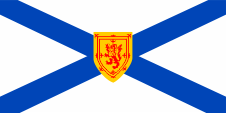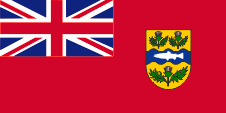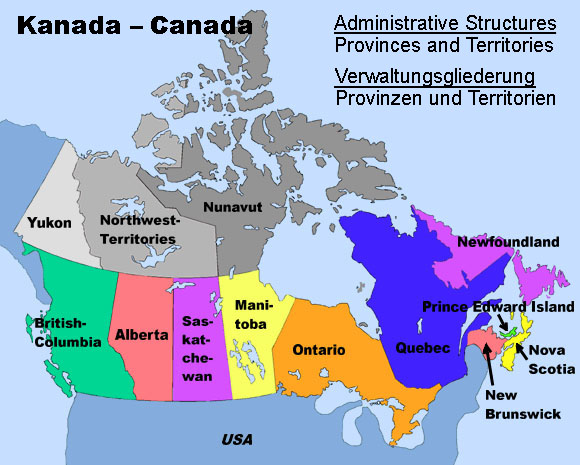Neuschottland |
|
|
|
| Übersicht – Contents: | |
Neuschottland |
|
|
|
| Übersicht – Contents: | |
Flagge – Flag: |
|
 |
Provinzflagge – flag of the province, Seitenverhältnis – ratio = 1:2, Quelle/Source, nach/by: Corel Draw 4, Flaggen Enzyklopädie   |
historische Flaggen – historical Flags: |
|
 |
1625–1868, Quelle/Source, nach/by: Corel Draw 4, Flaggen Enzyklopädie   |
 |
1868–1929, Provinzflagge – flag of the province, Seitenverhältnis – ratio = 1:2, Quelle/Source, nach/by: World Statesmen, Wikipedia (D) |
Bedeutung/Ursprung der Flagge – Meaning/Origin of the Flag: |
|
| Die heutige Flagge von Neuschottland wurde am 19.01.1929 erstmals offiziell gehisst. Es ist eine Wappenflagge, denn sie zeigt das Design des Wappens der Provinz. | The today's flag of Nova Scotia was officially hoisted for the first time on 19th of January in 1929. It is a scutcheon flag, because it shows the design of the coat of arms of the province. |
| Die Provinzflagge darf, wie in den anderen kanadischen Provinzen auch, nicht nur von Ämtern und Behörden, sondern auch von Privatpersonen verwendet werden. | The provincial flag may, as in the other Canadian provinces, not only be used by governmental offices, authorities and departments, but also by private individuals. |
| Die heutige Flagge von Neuschottland wurde wahrscheinlich schon 1625 verwendet, als König Karl I. Neuschottland das heutige Wappen verlieh. Nachgewiesen ist sie aber erst im Jahre 1858. Im Jahre 1868 musste man sich offenbar dem britischen Ensign-System unterwerfen. Normalerweise hätte die Provinz, wie alle anderen auch, keine eigene Flagge haben und nur die britische bzw. ab 1870 die kanadischen Flaggen verwenden dürfen. Dennoch hat man, wie in allen anderen Provinzen auch, eine eigene Flagge haben wollen, die, wie in allen anderen Provinzen auch, nie genehmigt wurde. Man legte sich offenbar und ausgerechnet einen Red Ensign zu, der das damalige Wappenschild der Provinz im wehenden Ende zeigte. Ein klarer Verstoß gegen das Ensign-System, denn ein Red Ensign wird von der britischen Admiralität zusätzlich zum Blue Ensign verliehen. Einen solchen gab es gar nicht. Schließlich wurde 1929 das alte Modell wieder eingeführt. Die historischen Flaggen der Provinz folgen aus der Historie heraus britischen Vorgaben. Es gelten: Blau = Pantone 280, Rot = Pantone 186, Gelb = Pantone 116. Für die heutige Flagge gilt: Blau = Pantone 293, Rot = Pantone 186, Gelb = Pantone 122. | The
current flag of Nova Scotia was probably in use as early as 1625 when King Charles I.
gave Nova Scotia its current coat of arms. However, it is only proven in 1858.
In 1868, it seemed that they had to submit to the British Ensign system. Normally the province would, like every other province too, not have had its own flag and should only have used the British flags or, from 1870, the Canadian flags. Nevertheless they wanted, like as in all other provinces, to have its own flag, which, like as in all other provinces, never was approved. They, apparently and significantly, introduced a Red Ensign, which showed the then coat of arms of the province in the flying end. A clear violation of the Ensign system, because a Red Ensign is always awarded by the British Admiralty in addition to the Blue Ensign. There was no Blue Ensign at all. Finally, in 1929, the old model was reintroduced. The historical flags of the province follow British specifications due to history. They are: Blue = Pantone 280, Red = Pantone 186, Yellow = Pantone 116. For today's flag they are: Blue = Pantone 293, Red = Pantone 186, Yellow = Pantone 122. |
Großbritannien hatte in Jahr 1864 ein Flaggensystem eingeführt, in dem:
Seit 1865 durften Schiffe von Kolonialregierungen einen Blue Ensign mit einem Badge (Abzeichen) im fliegenden Ende führen. Die jeweiligen Regierungen sollten entsprechene Bagdes zur Verfügung stellen. Handelsschiffe und seefahrende Privatpersonen aus Kolonien dürfen nur dann einen Red Ensign mit Badge führen, wenn von der britischen Admiralität eine entsprechende Erlaubnis für die Kolonie erteilt wurde. |
United Kingdom introduced a flag system in 1864 in which:
Since 1865 ships of colonial governments were permitted to fly the Blue Ensign with a badge in the flying end of the flag. The respective governments were asked to design appropriate badges. Merchant ships and seafaring persons from colonies were only permitted to use the Red Ensign with a badge, then also named Civil Ensign, if permission has been given to the respective colony by the British admiralty. |
| Ein solches Badge war oft eine auf einer Scheibe platzierte regionale landschaftliche Darstellung, zeigte oft Schiffe, historische Begebenheiten oder konnte auch nur eine Art Logo sein. Sehr oft zeigte ein Badge zusätzlich den Namen des Landes oder auch einen Wahlspruch. Einige Besitzungen hatten aber auch schon von Anfang an ein Wappen, bzw. erhielten über die Jahre eine eigenes Wappen und das Badge wurde abgeschafft. Um ein weitgehend einheitliches Erscheinungsbild im fliegenden Ende der Flaggen zu gewährleisten, wurden Wappen und auch andere Symbole auf einer weißen Scheibe in der Größe der früheren Badges dargestellt. Es gab hier aber auch Ausnahmen, denn einige Kolonien verwendeten diese weiße Scheibe nicht, und platzierten ihr Wappen oder auch nur das Wappenschild - manchmal auch vergrößert - direkt auf das Flaggentuch. Schon in den 40-er Jahre wurde dazu übergegangen die weiße Scheibe zu entfernen und das Wappen direkt zu platzieren oder vergrößert dazustellen. Dieser Umstellungsprozess erfolgte allmählich, nirgendwo gleichzeitig und vollständig. In einigen britischen Besitzungen sind bis heute Flaggen mit der weißen Scheibe in Gebrauch, in anderen nicht mehr und in einigen Gebieten gibt es beide Varianten nebeneinander. |
Such a badge was often a regional landscape representation placed on a disk,
often showing ships, historical events or even a kind of a logo. Very often,
a badge also showed the name of the country or a motto.
Some British possessions, however, already had a coat of arms from the beginning, or their badge was replaced by a coat of arms over the years. To ensure a uniform appearance in the flying end of the flags, coats of arms and other symbols were displayed on a white disk in the size of the earlier badges. There were also exceptions, because some colonies did not use the white disk and placed their escutcheon or even coat of arms directly on the bunting, sometimes enlarged. Already in the '40s they started to remove the white disk and placed the coat of arms directly or enlarged. This conversion process was done gradually, nowhere at the same time and completely. In some British possessions, flags with the white disc are still in use, in others no more and in some areas are both variants in use, next to each other. |
| Quelle/Source: Volker Preuß, Flaggen Enzyklopädie, World Statesmen, Die Welt der Flaggen, Wikipedia (EN) | |
Wappen – Coat of Arms: |
|
 |
Wappenschild von Neuschottland – escutcheon of Nova Scotia, Quelle/Source: Corel Draw 4 |
Bedeutung/Ursprung des Wappens – Meaning/Origin of the Coat of Arms: |
|
| Es gibt ein reguläres Wappen für Neuschottland, mit Postament, Schildhaltern, einer Wappenkrone und dem Motto. Hier dargestellt ist nur der zentrale Teil des Wappens, der Wappenschild. | There is a regular coat of arms for Nova Scotia, with a console, shield holders (supporters), withe a crest and the motto. Here is only depicted the central part of the coat of arms, the escutcheon. |
| Das Wappenschild Neuschottlands zeigt auf weißem Grund das Wappen Schottlands mittig über einem blauen Andreaskreuz. Es ist der Gestaltung der schottischen Flagge nachempfunden, da das Schild einer farblichen Umkehrung des schottischen "Saltire" entspricht. |
The escutcheon of Nova Scotia shows on white ground the coat of arms of Scotland
medially above a blue St. Andrew's Cross. It is designed corresponding to the scottish flag, because the shield correlates with the scottish "Saltire" in a reversal of the colours. |
| Quelle/Source: Volker Preuß, Wikipedia (EN) | |
| Landkarte – Map: |
 |
| Landkarte/Map: Volker Preuß |
Zahlen und Fakten – Numbers and Facts: |
|
|
|
|
|
|
|
|
|
|
|
|
|
|
|
|
|
Geschichte: |
|
ca. 10.000 v.Chr. · Besiedlung durch Vorfahren der Indianer vom
Stamme der Micmac ca. 1000 n.Chr. · Normannen erreichen die kanadische Ostküste 1497 · Giovanni Caboto (John Cabot), ein italienischer Seefahrer in Diensten Englands entdeckt Labrador, Neufundland und Kap Breton (Neuschottland) 1603–1606 · die Kolonisierungsexpedition des Samuel de Champlain streift auch das heutige Neuschottland 1608 · Champlain betreibt die Zusammenfassung aller französischen Besitzungen im heutigen Kanada unter dem Landesnamen "Neufrankreich" und beansprucht auch das heutige Neuschottland 1621 · der englische König Jakob I., der die Halbinsel ebenfalls beansprucht, verteilt zur Sicherung seiner Ansprüche Landrechte an Adelige aus Schottland, daher der Name Neuschottland 1663 · Neufrankreich (einschließlich Neuschottland) wird französische Kronkolonie 1713 · Friede von Utrecht, Frankreich muss Neuschottland, Neubraunschweig und die Insel Neufundland an Großbritannien abtreten, die Inseln Royale (die heutige Insel Cape Breton), St. Jean (die heutige Prinz-Eduard-Insel) und St. Pierre/Miquelon bleiben jedoch französisch 1730 · Frankreich errichtet die Festung Louisbourg auf der Insel Royale 1751 · Neuschottland wird eine eigenständige englische Kolonie 1749 · Gründung von Halifax 1751 · auf Initiative des englischen Königs Georg II. aus dem Hause Hannover wird die Stadt Lunenburg durch deutsche Siedler gegründet 1756 · Beginn des Siebenjährigen Krieges 1758 · die Engländer erobern die Festung Louisbourg 1763 · Friede von Paris, Frankreich muss alle nordamerikanischen Besitzungen an England (Britisch-Nordamerika) abtreten, außer St. Pierre und Miquelon 1783 · Einwanderung von Tausenden königstreuer US-Amerikaner 1784 · Aufteilung von Neuschottland in vier Provinzen ("Meeresprovinzen"), jedoch unter einem gemeinsamen Generalgouverneur: Neuschottland, Neubraunschweig, Kap-Breton-Insel und Prinz-Eduard-Insel, die Provinzen Kap-Breton-Insel und Prinz-Eduard-Insel werden später wieder zu Neuschottland eingezogen 1848 · Großbritannien gewährt Neuschottland beschränkte innere Selbstverwaltung 1867 · Gründung der Konföderation Kanada (Dominion of Canada – mit einem eigenen Parlament) auf Grund von Autonomieforderungen, Konföderation durch die vier Gründungsprovinzen Neubraunschweig, Québec, Ontario und Neuschottland 1873 · erneute Gründung und Ausgliederung der Provinz Prinz-Eduard-Insel |
History: |
|
ca. 10.000 B.C. · first settlement by ancestors of Indians of the
Micmac tribe ca. 1000 A.D. · Normans reach the Canadian eastern coast 1497 · Giovanni Caboto (John Cabot), an Italian seafarer in the service of England discovers Labrador, Newfoundland and Cape Breton (Nova Scotia) 1603–1606 · Samuel de Champlain's expedition of colonization touches even the today's Nova Scotia 1608 · Champlain powers the merge of all French possessions in the today's Canada under the name "New France" and demands also the today's Nova Scotia 1621 · the English King James I., hwo likewise claims the peninsula, distributes land claims for noblemen from Scotia, for the securing of his demands, from there the name Nova Scotia 1663 · New France (including Nova Scotia) becomes a French crown colony 1713 · Peace of Utrecht, France has to cede Nova Scotia, New Brunswick, and the Island of Newfoundland to United Kingdom, the islands Royale (the today's Cape Breton Island), St. Jean (the today's Prince Edward Island) and St. Pierre/Miquelon however remain French 1730 · France builds the Fortification of Louisbourg on Royale Island 1751 · Nova Scotia becomes an own English colony 1749 · foundation of Halifax 1751 · by initiative of the English king George II. from the House of Hanover gets established the City of Lunenburg by German settlers 1756 · beginning of the Seven Years War 1758 · the English conquer the Fortification of Louisbourg 1763 · Peace of Paris, France has to cede all its north american possessions to England (British Northern America), except St. Pierre and Miquelon 1783 · immigration of thousands loyal US-Americans 1784 · division of Nova Scotia into four provinces ("sea provinces"), however under one common Governor General: Nova Scotia, New Brunswick, Cape Breton Island and Prince Edward Island, the provinces Cape Breton Island and Prince Edward Island get later re-annexed to Nova Scotia 1848 · United Kingdom grants Nova Scotia limited internal self government 1867 · establishment of the Confederation of Canada (Dominion of Canada – with an own parliament) because of demands for autonomy, confederation by the four founding provinces New Brunswick, Québec, Ontario and Nova Scotia 1873 · once more establishment and excorporation of the Province of Prince Edward Island |
| Quelle/Source: Atlas zur Geschichte, World Statesmen, Wikipedia (D), Discovery '97 |
Ursprung des Landesnamens – Origin of the Country's Name: |
|
| Der Name der Provinz geht auf das Jahr 1621 zurück, als der der englische König Jakob I. begann, Landrechte an Adelige aus Schottland zu verteilen. | The name of the province dates back to the year 1621, when the English King James I. (James Charles Stuart) began to distribute land rights to nobles from Scotland. |
| Quelle/Source: Volker Preuß | |